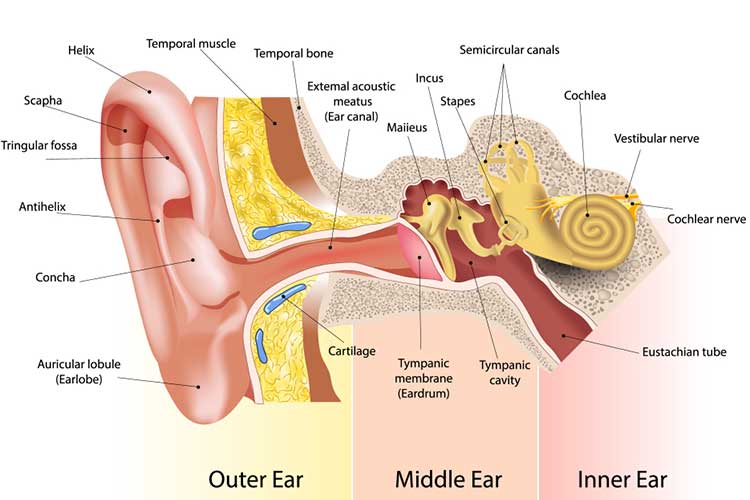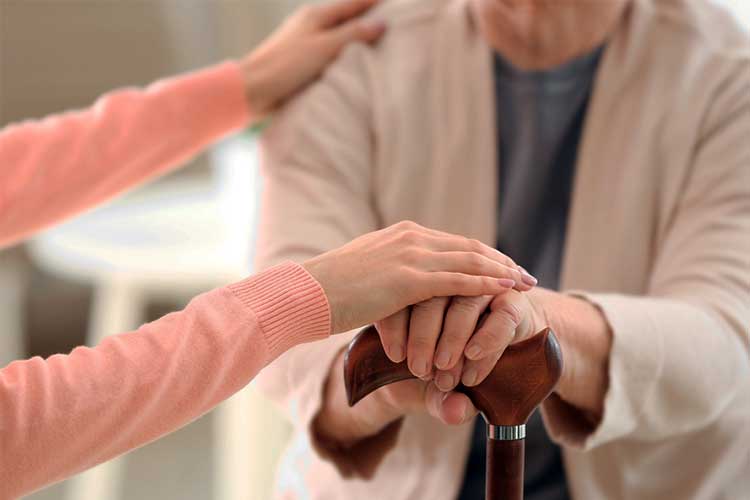Vertigo is a symptom associated with the sensation of movement. It includes spinning, tilting, and swaying. Vertigo is often described as a feeling that your surroundings are spinning around you.

The primary cause of vertigo is an inner ear problem or condition, the most common of these being benign paroxysmal positional vertigo (BPPV) (Healthdirect 2022).
Other causes of vertigo include:
- Vestibular neuronitis (inflammation of the vestibular nerve)
- Ménière's disease
- Labyrinthitis
- Certain medications (e.g., anticonvulsants)
- Head injuries
- Migraine
- Brain tumor
- Stroke
- Circulation problems
- Infections.
(Healthdirect 2022; Stanton & Freeman 2023; Mayo Clinic 2022a)
The feeling of vertigo might be barely noticeable, or it might be so severe that a person finds it very difficult to keep their balance and carry out everyday tasks. ‘Attacks’ of vertigo can happen very suddenly or last for a long time (NHS Inform 2024).
Generally, vertigo is not considered serious except when it increases the risk of falls (Mayo Clinic 2022b) or occurs during potentially dangerous situations, e.g., while driving.
Most of the listed causes of vertigo are benign; however, serious conditions such as multiple sclerosis, tumors, and psychogenic causes must be considered, particularly in the case of older patients and/or patients with a high risk of vascular disease (Dommaraju & Perera 2016).
Vertigo or Acrophobia?
The term ‘vertigo’ is often used incorrectly to describe a fear of heights (NHS Inform 2024). This misconception is perpetuated in popular media, most notably in Alfred Hitchcock’s classic 1958 film Vertigo. Hitchcock, however, was able to give audiences a fairly accurate sense of the unsettling feeling of vertigo through the use of the ‘dolly zoom’ camera effect (Johnson 2018).
‘Acrophobia’ is the medical term for a fear of heights and the dizzy feeling related to looking down from a very high place (NHS Inform 2024).

What’s the Difference Between Dizziness and Vertigo?
Dizziness encompasses a broad range of experiences, including lightheadedness, feeling as though you might faint, and feeling unsteady on your feet. Dizziness can be related to many factors, including cardiovascular or breathing pattern problems (Robinson 2016; Better Health Channel 2022a).
Vertigo creates the illusion of movement. Normally, the brain identifies that you are moving by integrating signals from your eyes, inner ear, and receptors that sense body movement in the neck and limbs (Robinson 2016). In a true case of vertigo, you feel as though the world moves around you even while you are standing still.
Vertigo is a common, distressing presentation in general practice and constitutes approximately 54% of cases of dizziness (Dommaraju & Perera 2016).
Benign Paroxysmal Positional Vertigo
Benign paroxysmal positional vertigo (BPPV) occurs when minuscule calcium crystals (known as otoconia) dislodge and cluster together in the wrong part of the semicircular canals in the inner ear, which are responsible for balance (Better Health Channel 2022a, b).
This affects the messages sent from the inner ear to the brain, causing the brain to incorrectly receive information that the head is moving even when it has only changed position slightly. This creates the false illusion of movement (Healthdirect 2022; Better Health Channel 2022b; Robinson 2016).
BPPV is often triggered by head movements such as looking up, rolling over in bed, or getting in/out of bed (Better Health Channel 2022b).
In vertigo, the inner ear signals are responsible for jerky, uncoordinated eye movements called nystagmus. This conflicts with the brain’s other signals of movement. These repeated attacks tend to last for less than 30 seconds (Robinson 2016).

Symptoms of Vertigo
Common symptoms associated with vertigo include:
- Feelings of spinning, falling, or the world spinning around you
- Loss of balance
- Nausea or vomiting
- Dizziness
- Sweating
- Appearing pale.
(Healthdirect 2022; NHS Inform 2024)
Risk Factors for Vertigo
BPPV can occur at any age but is most common in people over the age of 50. It’s more common in females than in males (Mayo Clinic 2022b).
A head injury or any disorder relating to the ear may also increase the risk of BPPV (Mayo Clinic 2022b).
People with migraines have roughly a 1 in 10 chance of experiencing a bout of vertigo that will come and go and can last for a few seconds to a few days. The treatment for this does not differ from that of treating migraines (Robinson 2016).
Treatment for Vertigo
Treatment must address the specific cause of vertigo. A physical examination to determine the cause will include neurological, cardiovascular, eye, and ear examinations (Dommaraju & Perera 2016).
Treatment options include:
- Vestibular rehabilitation: A type of physical therapy to strengthen the vestibular (balance) system.
- Exercise: Exercise prescribed by physiotherapists relating to eye movement; and balance stabilisation exercises.
- Canalith repositioning measures: A treatment that involves moving calcium deposits out of the ear canal to be absorbed by the body.
- Medicine: Motion sickness medication may relieve symptoms of vertigo, such as nausea. Antibiotics will treat a bacterial infection.
- Surgery: Surgery is only required in a few cases.
(Healthdirect 2020; Dommaraju & Perera 2016)

Patients should be directed to a specialist if they experience continuous vertigo, hearing loss, or headaches, or if the diagnosis is uncertain (Dommaraju & Perera 2016).
Limiting alcohol and coffee consumption and restricting salt intake are lifestyle changes recommended for patients with vertigo (Dommaraju & Perera 2016).
Test Your Knowledge
Question 1 of 3
In benign paroxysmal positional vertigo, what causes the sensation of spinning?
Topics
References
- Better Health Channel 2022a, Dizziness, Vertigo and Balance Disorders, Victoria State Government, viewed 28 October 2024, https://www.betterhealth.vic.gov.au/health/ConditionsAndTreatments/dizziness-and-vertigo
- Better Health Channel 2022b, Benign Paroxysmal Positional Vertigo (BPPV), Victoria State Government, viewed 28 October 2024, https://www.betterhealth.vic.gov.au/health/conditionsandtreatments/benign-paroxysmal-positional-vertigo-bppv
- Dommaraju, S & Perera, E 2016, ‘An Approach to Vertigo in General Practice’, Australian Family Physician, vol. 45, no. 4, viewed 28 October 2024, https://www.racgp.org.au/afp/2016/april/an-approach-to-vertigo-in-general-practice/
- Healthdirect 2022, Vertigo, Australian Government, viewed 28 October 2024, https://www.healthdirect.gov.au/vertigo
- Johnson, TL 2018, ‘13 Facts About Vertigo’, Mental Floss, 4 July, viewed 28 October 2024, https://www.mentalfloss.com/article/548532/facts-about-vertigo
- Mayo Clinic 2022a, Dizziness, Mayo Clinic, viewed 28 October 2024, https://www.mayoclinic.org/diseases-conditions/dizziness/symptoms-causes/syc-20371787
- Mayo Clinic 2022b, Benign Paroxysmal Positional Vertigo (BPPV), Mayo Clinic, viewed 28 October 2024, https://www.mayoclinic.org/diseases-conditions/vertigo/symptoms-causes/syc-20370055
- NHS Inform 2024, Vertigo, National Health Service Scotland, viewed 28 October 2024, https://www.nhsinform.scot/illnesses-and-conditions/ears-nose-and-throat/vertigo
- Robinson, A 2016, ‘Everything You Ever Wanted to Know About Vertigo (But Were Too Dizzy to Ask)’, The Guardian, 30 May, viewed 28 October 2024, https://www.theguardian.com/lifeandstyle/2016/may/29/vertigo-migraines-dizziness-ear-infection-health-guide
- Stanton, M & Freeman, AM 2023, ‘Vertigo’, StatPearls, viewed 28 October 2024, https://www.ncbi.nlm.nih.gov/books/NBK482356/

